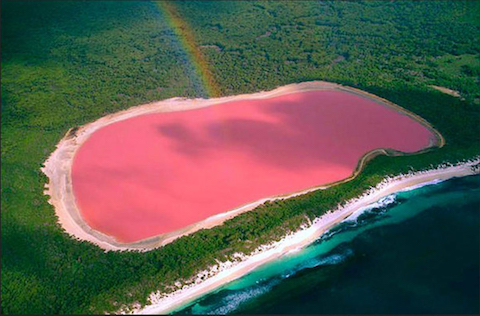
Credit: Kurioziteti123, CC BY-SA 4.0, via Wikimedia Commons
In a few rare places in the world, there are salt lakes that are flamingo pink.
To understand what gives them their bright color, we should first understand what makes flamingos pink.
The birds spend much of their lives wading and feeding in shallow lakes that aren’t pink but are salty and hold the flamingo’s favorite food: brine shrimp.
These shrimp are pink, colored by high concentrations of beta-carotene—the same pigment that makes carrots orange. After a couple years of eating shrimp, flamingos, which start out gray, have consumed enough beta-carotene to turn their feathers pink.
But what makes the shrimp pink? It’s also something they eat.
In these salty lakes lives a particular kind of microalgae adapted to the saline water.
It starts out green, but to protect itself from UV radiation, produces a pigment that acts as a natural sunblock: beta-carotene. Which turns the algae … pink.
So, pink algae make pink shrimp, which make flamingos pink.
But what about the pink lakes? They don’t have any flamingos in them. In fact, they’re so salty that almost nothing can live in them, except that microalgae.
And there’s so much of it that it colors the water red. When the sun shines through it and bounces off the light-colored bottom, we get a bright, flamingo-pink lake.
These pink lakes are valuable sources of both salt and beta-carotene, and for many years people have visited them to collect both.
Background
Synopsis: As he was exploring the southern coast of Australia in 1802, Mathew Flinders scrambled to the high point of an island and observed a baffling otherworldly sight: a bright pink lake. The lake is as salty as the Dead Sea, but what makes it flamingo pink? Hypersaline bacteria and algae that protect themselves from ultraviolet light (UV) damage using beta-carotene. They are the same organisms that color the brine shrimp that flamingos dine upon that end up coloring the feathers of the flamingos. These organisms thrive in salty lakes and commercial salt evaporation ponds, resulting in a range of vivid colors.
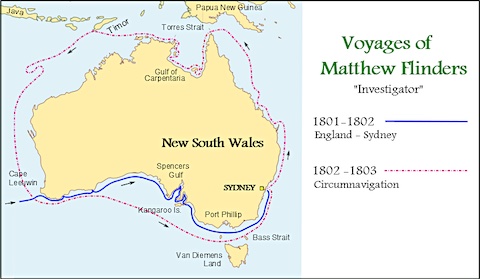
Credit: Adapted from illustrations in Australian Navigators by Robert Tiley (2002)
- English navigator and cartographer Matthew Flinders led expeditions to map Terra Australis (the 15th–18th-century Latin name for an unknown southern continent meaning “South Land”) and is credited with naming the continent “Australia.”
- As commander of the ship HMS Investigator, Flinders surveyed the southern coast of Australia in 1802 and circumnavigated the entire continent in 1803.
- On January 15, 1802, he climbed to the top of a peak on the largest of a series of coastal islands and was surprised to see a bright pink lake.
- Flinders’s journal says, "In the north-eastern part was a small lake of a rose color, the water of which, as I was informed by Mr. Thistle who visited it, was so saturated with salt that sufficient quantities were crystallized near the shores to load a ship. The specimen he brought on board was of a good quality and required no other process than drying to be fit for use.”
- On his second excursion in 1803, Flinders returned to Middle Island in May, intending "to stop a day or two in Goose-Island Bay, for the purposes of procuring geese for our sick people, seal oil for our lamps, and a few casks of salt from the lake on Middle Island."
- While there, crew member William Hillier died of dysentery, and Flinders named the unusual lake after him.
- In 1889, settlers tried salt mining for about a year but the enterprise failed, partly because of the toxicity of the salt collected.
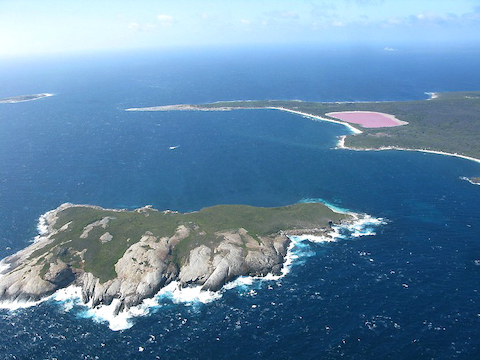
Credit: Aussie OC, Wikimedia Commons
- Middle Island is part of the Recherche Archipelago along the southern coast of the state of Western Australia, about 450 mi (725 km) east of Perth, near the town of Esperance.
- Today the island is an uninhabited nature reserve with restricted access.
- Lake Hillier is only about 2,000 ft (600 m) long and 820 ft (250 m) wide. It is surrounded by a dense eucalyptus forest on three sides and a strip of sand adjacent to the ocean.
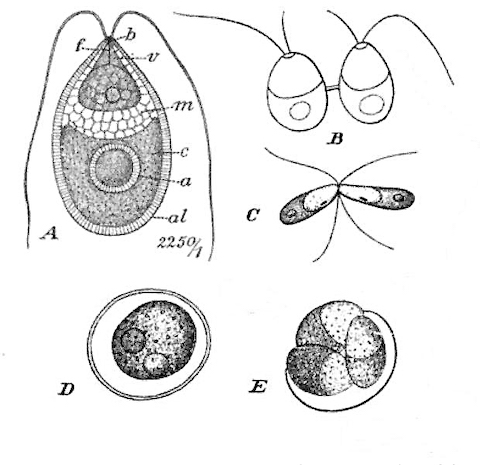
Credit: Adolf Engler, K. Prantl, public domain, via Wikimedia Commons
- The lake is vibrant pink throughout the year, and the hypersaline water from the lake remains a clear bright pink when sampled, thanks to microbial extremophiles.
- In 2016, researchers from the Extreme Microbiome Project performed metagenomic DNA studies on Lake Hillier water to identify its microbes.
- They found abundant microalgae known as Dunaliella salina in the lake water and a red halobacterium called Salinibacter ruber and a few species of Archea in the salt crusts along the lakeshore.
- A few other halophilic microbes were also noted, and research continues on the source of the colorful phenomenon.
- Some algae have evolved to occupy different extreme environmental niches. Dunaliella salina is one of these, tolerating salt concentrations up to 35%—that’s ten times the salinity of seawater. These algae can also be found in the Dead Sea.
- Many microbes are colorless, but algae are photosynthetic, so they need pigment. Dunaliella salina is a green alga that produces its energy by photosynthesis and protects itself from extreme UV radiation by producing a red pigment called beta-carotene, the same pigment that makes carrots orange.
- Halobacteria also secrete beta-carotene for UV protection.
- These red pigments turn the lake water reddish, and the pale sandy bottom renders it a vivid pink hue from a distance.
- Beta-carotene is an important antioxidant that our bodies use to make vitamin A, which is important for vision, immunity and cell regrowth, so it is commonly used in cosmetics, food additives and as natural yellow-orange food coloring.
- Although the algae are harmless, drinking saline water is very dangerous.
- Theoretically you could swim in Lake Hillier, but access to the island is restricted by the Australian government, so an air tour is the best option for a visit.
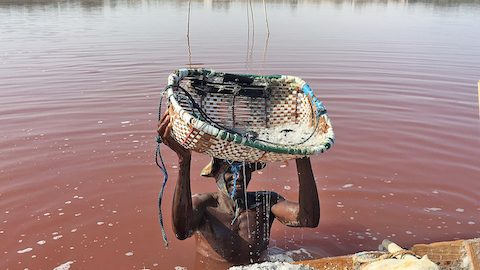
Credit: 林戈亮, CC BY-SA 4.0, via Wikimedia Commons
- Other hypersaline pink lakes can be found in hot, dry climates around the world.
- Senegal’s Lake Retba used to be the finish line for the famous Dakar Rally road race.
- Spain’s Salinas de Torrevieja and Bonaire’s pekelmeeren are also pink.
- There are four lakes in the southeastern Australian state of Victoria at Murray-Sunset National Park that turn pink as their salinity increases in late summer.
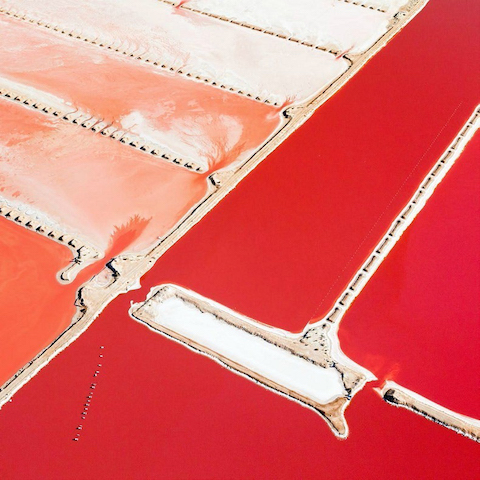
Credit: Steve Back, Amusing Planet
- Commercial salt evaporation ponds go through colorful cycles as they desiccate, with some producing salt and others producing beta-carotene.
- On the west coast of Australia, Hutt Lagoon hosts the world’s largest system of microalgae farms dedicated to the production of beta-carotene.
- Seawater constantly replenishes the 8.7x1.25-mi (14x2-km) lagoon as it seeps from the Indian Ocean through the adjacent beach and dunes and is separated into a variety of artificial ponds where it evaporates.
- Notable salt evaporation systems exist in France, Chile, Peru, Portugal, Mexico and in the United States, in San Francisco Bay.
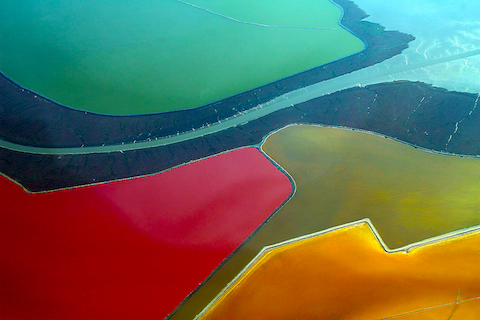
Credit: Doc Searls from Santa Barbara, USA, CC BY 2.0, via Wikimedia Commons
- These algae do more than color lakes pink, they also color flamingos!
- Flamingos thrive in salty lakes where they can find their favorite food—a brine shrimp called Artemia salina.
- Young flamingos are gray and become pink as they consume more and more brine shrimp, concentrating a coloring agent called astaxanthin in their feathers.
- The brine shrimp have a favorite food also—Dunaliella salina algae.

Credit: Pedro Szekely, CC BY 2.0, via Wikimedia Commons

